 advertisements advertisements
|

|
Former NASA astronaut Steven Nagel dies
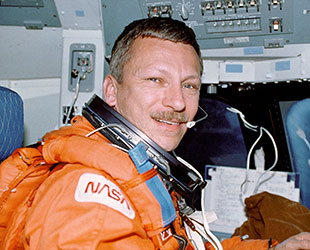
Astronaut Steven Nagel is seen in the commander's seat aboard the space shuttle Atlantis during STS-37 in April 1991. (NASA) |
August 22, 2014 — NASA astronaut Steven Nagel, who flew four space shuttle missions, died Thursday (Aug. 21). He was 67.
Nagel died after a long battle with cancer, the Association of Space Explorers stated on Facebook. The international organization, to which Nagel belonged, includes more than 350 men and women who have flown in space.
Nagel joined the astronaut corps in 1978 with NASA's first group of trainees selected for the space shuttle program. Although he was chosen to pilot the orbiter, his first flight was as a mission specialist, a position generally assigned to scientists and engineers.
"I really wanted to fly as a pilot, so at the time — because there was no explanation that went with it — I wondered, 'Are they telling me I'm not good enough to fly as a pilot?'" Nagel told a NASA interviewer about his 1985 assignment to the shuttle Discovery's STS-51G crew. "Nothing against mission specialists. I would trade my pilot's slot to go be a mission specialist and do a [spacewalk], certainly, but it's just that 'What are they trying to tell me here?'"

Early official NASA portrait of astronaut Steven Nagel. (NASA) |
"But I think what it really was, our class was very large, and they're getting down to the point where I think [they] probably wanted to get us all flown, and this was a way to do it a little quicker," Nagel recalled.
Nagel's first week in Earth orbit included helping to deploy three communications satellites for AT&T, Mexico and the Arab Satellite Communications Organization, as well as a free-flying platform devoted to astronomy experiments and an experiment for the Department of Defense's Strategic Defense Initiative (colloquially known as "Star Wars").
In the pilot seat
Nagel's turn in the pilot seat came on his second flight.
Nagel launched in late October 1985 as part of the eight-member STS-61A crew onboard space shuttle Challenger. The week-long flight, which set the still-standing record for the most people to have launched and landed on the same spacecraft, was also the first shuttle mission to be funded and directed by another nation: the former West Germany, overseeing the European-built Spacelab module mounted in Challenger's payload bay.
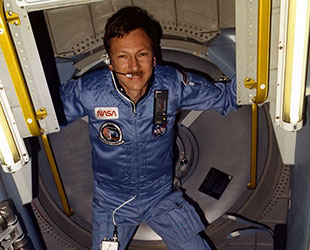
STS-61A pilot Steven Nagel floats inside the Spacelab module in space shuttle Challenger's payload bay, November 1985. (NASA) |
"Not having a U.S. manager made it more complex, but I see that mission was kind of an early lead-in to the space station," Nagel told a NASA interviewer in 2002. "Maybe in a way a Spacelab is kind of like a mini space station. You are doing scientific work, but your space station is inside the shuttle, and you're up there, in our case, a week."
As the mission's pilot, Nagel did not have much to do with 75 experiments being conducted inside the Spacelab, but that left time for observing the planet below.
"Jokingly, I said all I did on the second mission was purge fuel cells, dump water, take pictures, and prepare meals for the crew. I had no responsibility for any experiments in the back, so we were helping them out as much as we could," Nagel told a NASA interviewer in 2002.
"The orbiter crew had time to look out the window," Nagel noted. "So it was just a bonanza of Earth observations. It was great."
The worst of times, the best of times
The STS-61A mission was the last successful flight of the shuttle Challenger before the orbiter and its 51L mission's crew was lost in flight in January 1986. Nagel watched the ill-fated launch from a conference room at Johnson Space Center in Houston, but he was promptly sent to Florida to assist with the recovery of the shuttle's debris.
He then represented the Astronaut Office in NASA's effort to develop a crew escape system to improve the safety of the orbiters. Initially, the idea was to use a rocket-powered extraction method but ultimately a simpler extendable pole was adopted.
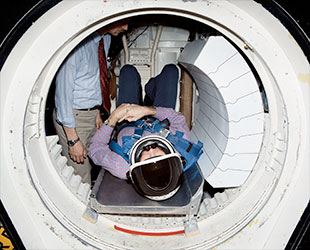
Astronauts Steve Nagel (left) and Sonny Carter conduct a shuttle escape system test at Johnson Space Center in 1987. (NASA) |
"This was my best time at NASA, actually," Nagel stated. "Nothing I ever did was more fulfilling than that two years, to be honest, even flying." "This was better, because everybody was so focused on getting the shuttle flying again," he remarked.
The shuttle was returned to flight in 1988, and three years later, Nagel followed as the commander of Atlantis' STS- 37 crew. The six-day mission was charged with deploying the Compton Gamma Ray Observatory (GRO), the second of NASA's "Great Observatories," which also included the Hubble Space Telescope.
"The GRO was big," Nagel said. "It was not physically as long as the Hubble, but it weighed a lot more. It was a lot denser. It was a great big thing, about 35,000 pounds, and it had three appendages that had to unfold once you get it out in the end of the [shuttle's robotic] arm."
The first two of those appendages, the solar array wings, extended slowly one at a time. The third however, failed to move. To fix the problem, crew members Jerry Ross and Jay Apt were sent outside on a spacewalk.
"That was the first — what would you call it? Unscheduled EVA," Nagel said. "It was planned as a contingency, but it was certainly not on the schedule. It was successful."
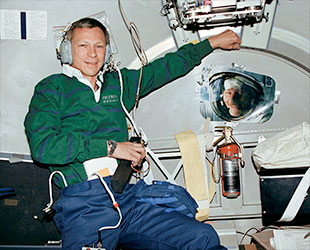
STS-55 commander Steven Nagel wears a headset and holds an amateur radio transceiver on space shuttle Columbia. (NASA) |
Fourth and final flight
Nagel's fourth and final launch in April 1993 got off to a late start. Already delayed from February due to technical concerns, the shuttle Columbia's three main engines shut down at just T-3 seconds prior to liftoff as a result a valve leak on March 22. The abort postponed the flight another month as all three engines were replaced.
Once in space, Nagel and his STS-55 mission crewmates conducted experiments as part of the second German-led Spacelab flight. They also became on-orbit plumbers.
"'You've got to stop using the toilet.' Sounds funny on the ground. For real, this is, there was nothing life-threatening about it, but it could be mission-threatening. If you cannot get this problem resolved, you're coming home. And what a tragedy that would be for the millions of dollars invested in this mission," Nagel told a NASA interviewer.
A nitrogen leak had disabled the system used to flush the waste water from the toilet. So Nagel and his crew had to divert the water from its tank into a contingency bag.
"Periodically we'd have to empty the bag," Nagel recalled. "You dump the water overboard out a port on the side of the orbiter ... except instead of gas pressure to dump, one of us would have to squeeze the bag to dump the waste water."

NASA portrait of STS-55 commander Steven Nagel. (NASA) |
"It got us through the mission," Nagel continued. "So who argues with success?"
Overall, the mission was a success. Over the course of the ten days, the flight logged the 365th day in space for the shuttle fleet and 100th day in orbit for Columbia. With the landing, Nagel had spent a total of 30 days, 1 hour and 34 minutes in space.
Fortuitous timing
Steven Ray Nagel was born on Oct. 27, 1946 in Canton, Illinois. He earned his bachelors in aerospace engineering from the University of Illinois in 1969 and his masters in mechanical engineering from California State University in 1978.
Nagel joined the U.S. Air Force Reserve Officer Training Corps in 1969 while still attending the University of Illinois. He completed his undergraduate pilot training at Laredo Air Force Base in Texas and subsequently reported to Luke Air Force Base in Arizona.
From October 1970 to July 1971, Nagel was an F-100 pilot with the 68th Tactical Fighter Squadron in Louisiana. He served a one-year tour of duty as a T-28 jet instructor for the Laotian Air Force in Thailand, prior to returning to the U.S. to assume A-7D instructor pilot and flight examiner duties at England Air Force Base back in Louisiana.
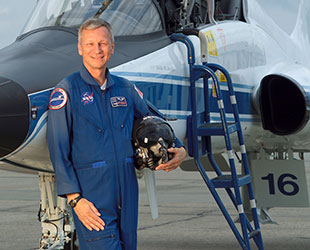
Astronaut Steven Nagel poses with a T-38 training jet at Ellington Field in Houston, Texas in April 2005. (NASA) |
Nagel graduated from the Air Force Test Pilot School at Edwards Air Force Base in California in December 1975 and was assigned to the 6512th Test Squadron located at the base. It was there where he had his first brush with the NASA astronaut corps.
"The astronauts who were involved in the early shuttle flights, some of them wanted to fly this [A-7D] airplane. And I was the only one around, as it turned out, to check them out," Nagel said. "I checked out Fred Haise, Gordon Fullerton, Joe Engle, Dick Truly, and Vance Brand."
"It was just fortuitous for me, because when it came time, when I applied [to be an astronaut] I didn't go ask them for any special favors, but they knew me. So it just happened at the right time in my life," he said.
An incredible professional and leader
In addition to his spaceflights, Nagel served as a backup T-38 chase pilot for STS-1, the first space shuttle mission in April 1981, and in mission control as Capcom (capsule communicator) for the re-entry and landing of STS-3, the first and only shuttle mission to land in New Mexico.
Nagel also worked on flight software development in the Shuttle Avionics Integration Laboratory (SAIL) at Johnson Space Center, and in 1991, served as the acting chief of the Astronaut Office.
After his final spaceflight, Nagel retired from the Air Force in February 1995 and, one month later, resigned from the astronaut corps. He continued at NASA however, serving full time as the deputy director for operations development in the Safety, Reliability, and Quality Assurance Office at Johnson.
In September 1996, Nagel moved to the aircraft operations division, flying as a research pilot and serving as chief of aviation safety and deputy division chief, before departing the space agency in May 2011.
"Steve has served the agency for more than 30 years," Janet Kavandi, NASA's director of Flight Crew Operations and an astronaut, said at the time of his retirement. "He's an incredible professional and leader, sharing his expertise and experience with everyone who has had the pleasure to work with him."

Astronauts and spouses Linda Godwin and Steven Nagel. (MU) |
Soon after his departure, Nagel accepted a position at the University of Missouri's College of Engineering, serving as an instructor in the mechanical and aerospace engineering department.
A recipient of numerous honors, Nagel was bestowed the Air Force's Distinguished Flying Cross and the Air Medal, as well as four NASA Space Flight medals for his service to the nation's space program.
Nagel is survived by his wife and fellow astronaut Linda Godwin and their daughters, Whitney and Lauren. Though they had both flown on STS-37, Nagel and Godwin were not married until after Nagel left the astronaut office. Nagel was previously married to Linda Diane Penney. |

© 2023 collectSPACE.com All rights reserved.
Questions? E-mail contact@collectspace.com

|
|

|

|
